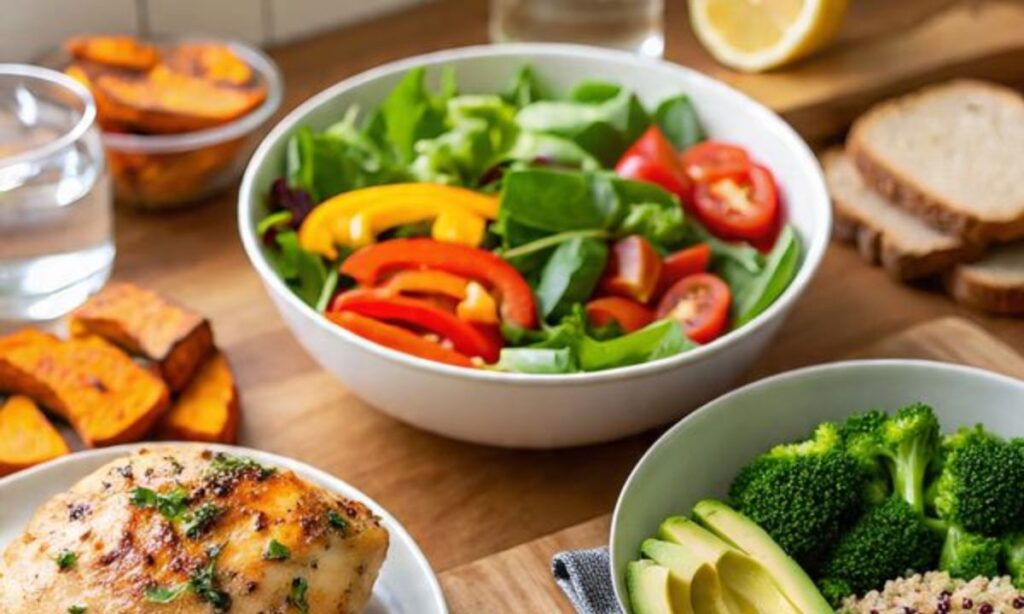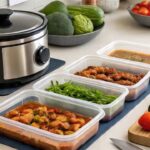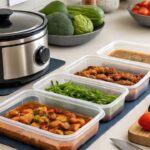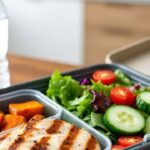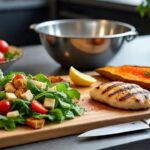Maintaining a low-sodium diet is essential for heart health, blood pressure management, and overall wellness. By planning and prepping your meals ahead of time, you can control your sodium intake while still enjoying flavorful and nutritious dishes. This guide will give you practical low-sodium meal prep ideas, tips, and sample meal plans.
Why Choose Low-Sodium Meal Prep?
A low-sodium diet offers several health benefits:
- Supports Heart Health: Reduces strain on the heart and arteries.
- Lowers Blood Pressure: Helps manage hypertension naturally.
- Minimizes Bloating: Less water retention and swelling.
- Boosts Overall Wellness: Encourages healthy eating habits and portion control.
Tips for Successful Low-Sodium Meal Prep
- Read Labels Carefully: Choose products labeled “low-sodium” or “no added salt.”
- Use Fresh Ingredients: Fresh vegetables, lean meats, and whole grains are naturally low in sodium.
- Flavor with Herbs & Spices: Replace salt with herbs, spices, citrus juice, and garlic for flavor.
- Cook in Bulk: Save time and control ingredients by cooking larger batches.
- Store Properly: Use airtight containers to maintain freshness and prevent spoilage.
Low-Sodium Ingredients to Include
| Ingredient Type | Examples | Benefits |
|---|---|---|
| Proteins | Chicken breast, turkey, tofu, lentils | Lean, high-quality protein without added salt |
| Vegetables | Spinach, broccoli, zucchini, bell peppers | Nutrient-rich and naturally low in sodium |
| Whole Grains | Quinoa, brown rice, oats | Long-lasting energy and fiber |
| Healthy Fats | Olive oil, avocado, nuts (unsalted) | Heart-friendly fats |
| Flavor Boosters | Lemon juice, fresh herbs, garlic, ginger | Adds taste without extra sodium |
Sample Low-Sodium Meal Prep Plan
| Meal | Dish Idea | Key Ingredients |
|---|---|---|
| Breakfast | Overnight oats with fresh berries & chia seeds | Rolled oats, almond milk, blueberries |
| Lunch | Quinoa & vegetable bowl with lemon-tahini dressing | Quinoa, spinach, cucumbers, tahini |
| Snack | Fresh veggie sticks with hummus (low-sodium) | Carrots, celery, low-sodium hummus |
| Dinner | Herb-roasted chicken with steamed broccoli | Chicken breast, rosemary, broccoli |
Low-Sodium Meal Prep Ideas by Category
Breakfast Ideas
- Greek yogurt parfait with unsalted nuts and fresh fruit.
- Vegetable omelet with spinach, mushrooms, and peppers.
- Smoothie made with spinach, banana, and unsweetened almond milk.
Lunch Ideas
- Lentil salad with cucumber, cherry tomatoes, and lemon dressing.
- Turkey and avocado wrap with whole wheat tortilla (no added salt).
- Brown rice with stir-fried vegetables and tofu.
Dinner Ideas
- Baked salmon with lemon and garlic green beans.
- Zucchini noodles with low-sodium tomato sauce.
- Grilled chicken with sweet potato mash and steamed broccoli.
Snack Ideas
- Apple slices with unsalted peanut butter.
- Air-popped popcorn (unsalted) with nutritional yeast.
- Mixed fresh berries or a small handful of unsalted almonds.
Flavorful Low-Sodium Seasoning Ideas
Replace salt with these delicious seasonings:
- Fresh herbs like basil, cilantro, parsley, and thyme.
- Citrus zest or juice (lemon, lime, orange).
- Garlic, onion, and ginger.
- Vinegars such as apple cider or balsamic.
- Salt-free seasoning blends like Mrs. Dash or homemade mixes.
Storage and Reheating Tips
- Use Airtight Containers: Prevents moisture loss and contamination.
- Label Your Meals: Include dates to track freshness.
- Freeze in Portions: Store extra meals in the freezer for quick access.
- Reheat Gently: Use a stovetop or microwave at low heat to preserve taste and texture.
FAQs About Low-Sodium Meal Prep
Q1. How much sodium should I consume daily?
Most health organizations recommend limiting sodium to 2,300 mg per day, with an ideal limit of 1,500 mg per day for optimal heart health.
Q2. Can low-sodium meals still taste good?
Absolutely! Using fresh herbs, spices, citrus, and vinegar can enhance flavor without relying on salt.
Q3. How can I make low-sodium meal prep faster?
Batch-cook staples like grains, roasted veggies, and proteins on one day, then mix and match throughout the week.
Q4. Are frozen vegetables good for low-sodium diets?
Yes—choose unsalted or “no added salt” frozen vegetables to save time and maintain nutrients.
Q5. Can I use canned goods?
Yes, but rinse them under water to remove excess sodium, or choose “low-sodium” labeled cans.
Key Takeaways
- Meal prepping is one of the best strategies for maintaining a low-sodium diet.
- Focus on whole, fresh foods and flavor with herbs, spices, and citrus instead of salt.
- Store meals properly and label them to ensure freshness.
- Plan ahead to save time and stay consistent with your dietary goals.
Final Thoughts
Low-sodium meal prep doesn’t have to be bland or complicated. By selecting fresh ingredients, using creative seasonings, and planning your meals in advance, you can enjoy healthy, flavorful dishes all week long—while keeping your sodium intake in check.
